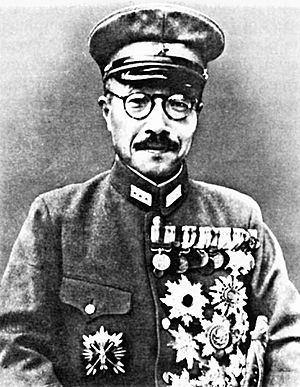Hideki Tōjō facts for kids
Quick facts for kids
Hideki Tōjō
|
|
|---|---|

A portrait of Hideki Tojo
|
|
| Prime Minister of Japan (Leader of the Taisei Yokusankai) |
|
| In office October 17, 1941 – July 22, 1944 |
|
| Preceded by | Fumimaro Konoe |
| Succeeded by | Kuniaki Koiso |
| Minister of War | |
| In office 22 July 1940 – 22 July 1944 |
|
| Preceded by | Hata Shunroku |
| Succeeded by | Hajime Sugiyama |
| Personal details | |
| Born | December 30, 1884 Hamachi district of Tokyo, Empire of Japan |
| Died | December 23, 1948 (aged 63) Tokyo, occupied Japan |
| Citizenship | Japanese |
| Political party | Imperial Rule Assistance Association (1940–1945) |
| Spouse | Katsuko Ito |
| Occupation | politician |
| Awards | Grand Cordon of the Order of the Rising Sun Order of the Golden Kite, 2nd Class Order of the Sacred Treasure |
| Signature |  |
| Military service | |
| Allegiance | Empire of Japan |
| Years of service | 1905-1945 |
| Rank | General |
| Battles/wars | February 26 Incident Second Sino-Japanese War Operation Chahar Japanese invasion of Manchuria World War II Attack on Pearl Harbor |
Hideki Tōjō (born December 30, 1884 – died December 23, 1948) was an important leader in Japan during World War II. He served as the Prime Minister of Japan and was also a general in the Imperial Japanese Army.
Hideki Tōjō was born in Tokyo, Japan. His father was a high-ranking general in the Japanese Army. In 1909, Hideki Tōjō married Katsuko Ito. Together, they had seven children: three sons and four daughters.
Contents
Early Military Career
Tōjō started his career in the Army in 1902. He quickly moved up in rank. In the 1930s, he took part in the Second Sino-Japanese War. This was a conflict between Japan and China.
In March 1937, Tōjō became the chief of staff for the Kwantung Army. This army was a part of the Japanese military. He led military actions against Chinese forces in certain areas.
Rise to Power
By July 1940, Hideki Tōjō was chosen to be the Minister of War. This was a very powerful position in the Japanese government. He believed Japan should form an alliance with Germany and Italy. These countries were also known as the Axis Powers. They were against the Allied forces during World War II.
In 1941, Tōjō became the Prime Minister of Japan. Just two months later, he ordered a surprise attack on the U.S. naval base in Hawaii. This attack, known as the attack on Pearl Harbor, brought the United States into World War II.
Leadership During World War II
As Prime Minister, Tōjō was a key leader for Japan throughout much of World War II. He was in charge of both the political and military efforts of the country. During the war, many difficult decisions were made under his leadership. These actions led to great suffering for many people, including civilians and soldiers who were captured.
End of the War and Aftermath
Hideki Tōjō remained a powerful leader until 1944. At that time, Emperor Hirohito decided to reduce Tōjō's power. Japan surrendered to the Allied Powers in September 1945. After the war ended, Tōjō was arrested. He was held responsible for his actions during the war. He died on December 23, 1948.
Images for kids
-
Wang Jingwei of the Japanese-sponsored puppet government in Nanjing meeting with Tojo in 1942.
-
The Greater East Asia Conference in November 1943, participants left to right: Ba Maw, Zhang Jinghui, Wang Jingwei, Hideki Tojo, Wan Waithayakon, José P. Laurel, Subhas Chandra Bose.
-
Tōjō meets with Minister of Munitions Nobusuke Kishi, who later became a prime minister in postwar Japan.
-
Tōjō with wife Katsuko and granddaughter Yūko Tojo
See also
 In Spanish: Hideki Tōjō para niños
In Spanish: Hideki Tōjō para niños











